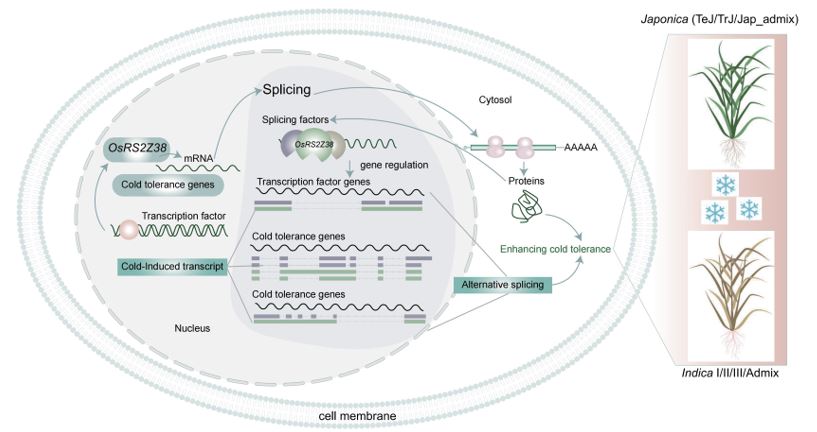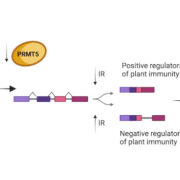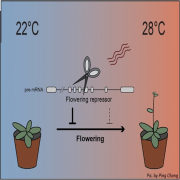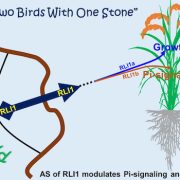Pan-transcriptomic analysis reveals mechanisms regulating crop cold responses
https://doi.org/10.1093/plcell/koae039
Zhong, Luo, Sun, et al.
Yuanyuan Zhong, Guangxi University; Yuhong Luo, Guangxi University; Jinliang Sun, Guangxi University; Xuemei Qin, Guangxi University; Ping Gan, Guangxi University; Zuwen Zhou, Guangxi University; Yongqing Qian, Guangxi University; Rupeng Zhao, Guangxi University; Zhiyuan Zhao, Guangxi University; Wenguo Cai, Guangxi University; Jijing Luo, Guangxi University; Ling-Ling Chen, Guangxi University; Jiaming Song, Southwest University.
Background: Cold stress significantly affects rice (Oryza sativa) growth, development, and productivity. Understanding the mechanisms that regulate stress responses in important crops like rice can help improve grain yield and plant stress resilience. One important regulatory mechanism is alternative splicing, a crucial post-transcriptional process in eukaryotes. In AS, the pre-mRNA from a single gene can produce multiple distinct mature mRNA isoforms, which can produce distinct proteins or undergo distinct regulation. Alternative splicing plays a key role in regulating plant responses to abiotic stress, contributing to increased resistance.
Question: Does alternative splicing have an important effect on cold stress responses in rice?
Findings: To answer this question, we constructed a rice pan-transcriptome combining transcriptome data from 11 rice lines under cold stress and characterized the transcriptional regulatory landscape of the cold response. This revealed that alternative splicing has a major influence on the cold stress response in rice. Further investigation confirmed the potential of two genes, OsCATC and Os03g0701200, as targets that could be used to enhance cold tolerance in rice by genetic engineering. Moreover, we demonstrated that splicing factors OsRS33 and OsRS2Z38 play pivotal roles in conferring cold tolerance to rice plants. Based on our evaluation of the cold tolerance of 165 rice cultivars and analysis of resequencing data for these cultivars, we propose that domestication-driven selection of the splicing factor gene OsRS2Z38 affected the adaptive evolution of Asian cultivated rice with respect to cold stress tolerance.
 Next steps: Building upon these findings, our upcoming studies will elucidate the functional roles and precise regulatory mechanisms of key splicing factors in modulating cold-induced alternative splicing in rice.
Next steps: Building upon these findings, our upcoming studies will elucidate the functional roles and precise regulatory mechanisms of key splicing factors in modulating cold-induced alternative splicing in rice.
Reference:
Yuanyuan Zhong, Yuhong Luo, Jinliang Sun, Xuemei Qin, Ping Gan, Zuwen Zhou, Yongqing Qian, Rupeng Zhao, Zhiyuan Zhao, Wenguo Cai, Jijing Luo, Ling-Ling Chen, Jia-Ming Song (2024). Pan-transcriptomic analysis reveals alternative splicing control of cold tolerance in rice. https://doi.org/10.1093/plcell/koae039
背景回顾:植物已经进化出复杂的机制来适应恶劣的环境条件,研究水稻等重要作物的适应性演化遗传规律能为现代作物实现增产抗逆提供新策略。冷胁迫严重影响水稻的各种生理过程,抑制其生长发育和经济产量。可变剪接(Alternative splicing,AS)是真核生物中重要的转录后调控机制,能够让单个基因转录产生的前体mRNA形成结构不同的成熟mRNA。已报道 AS 调节许多非生物胁迫反应从而促进植物抗逆性。然而,关于AS在水稻中如何参与冷胁迫反应的信息十分有限,AS调控对作物适应性演化的贡献也鲜有报道。
科学问题:可变剪切调控在水稻的冷胁迫响应中是否扮演了关键角色?并且,这种调控机制是否对作物物种适应性进化具有潜在的重要意义?
研究发现:我们基于11种水稻材料在冷胁迫下的转录组数据(Iso-Seq和RNA-Seq)构建了水稻泛转录组,表征不同水稻品种的冷响应转录调控景观。我们发现,低温触发了水稻快速大规模AS事件响应,AS是水稻应对冷胁迫的重要调控机制。进一步的研究确认了OsCATC和Os03g0701200这两个基因可作为增强水稻耐寒性工程改良的新候选目标。此外,我们揭示了剪切因子OsRS33和OsRS2Z38在水稻耐寒性中具有重要作用。OsRS2Z38基因的功能缺失显著影响水稻幼苗的耐寒性。此外,OsRS2Z38基因在籼稻和粳稻间具有不同的等位基因型,粳稻中携带的OsRS2Z38等位基因型可能在粳稻的冷适应中扮演了重要角色,即剪接因子OsRS2Z38的驯化选择参与亚洲栽培稻的适应性演化。
展望未来:我们系统地探讨了水稻在冷胁迫下的AS分布、动态变化及其调控机制,为深入理解植物在冷胁迫下的精确调控及揭示冷响应机制背后的遗传基础提供了新的见解和丰富的资源。基于以上研究成果,我们计划进一步对水稻关键的冷响应剪接因子的功能及其调控机制进行深入研究。









